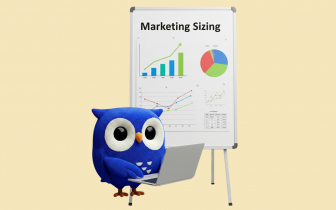Digital State of 2024: What Business Owners Should Know

The global digital landscape changes so fast. But as it’s almost impossible to seek success without being present online, you need to understand the main trends and changes taking place on the Internet.
What social networks do users prefer to use? How much time do people spend online? How the growing number of mobile does users change the game?
We’ve studied 550+ pages of the Digital 2024 Global Overview Report by DataReportal, Meltwater, and We Are Social to present you with the most important information.
Plus, we will share some useful sources to help you align your online marketing strategy further.
Main data regarding the digital state
8.08 billion is the current global population. It’s 0.9% times more compared to the last year.
The predominant part of people - 5.61 billion uses are unique phone subscribers and 5.35 billion uses the Internet.
That’s why we always repeat that it’s crucial for your business to be present online. Digital has become the habitual place of people’s habitance.
The smart device ownership only proves our thoughts:
- 97.6% of the global population owns smartphones,
- 57.7% of the global population owns laptops or desktops,
- 30.9% of the global population owns tablets.

Moreover, people actively use those devices to access the Internet.
- 98.1% of users go online via smartphones,
- 90.2% of users go online via laptop, desktop, or tablet.
Considering the preferred Internet access methods, it’s vital to remember that your site and marketing campaigns should be optimized for mobile.
Taking into account hassle-free access to the Internet and the growing time spent online (6 hours 40 minutes in 2024 - which is 0.8% more compared to the last year), make sure people see your website or social media online.
But let’s talk about the Internet in more detail.
Internet use in 2024
As mentioned above, 5.35 billion people use the Internet. What’s interesting is that more males (68.8%) go online than females (63.5%).
The global average Internet adoption rate is 66.2%. Which is relatively high. Yet, you need to understand that this is the median, so the maximum and minimum rates can change drastically.
Internet GEO
Nevertheless, if your business GEO is Americas, Europe, and Oceania, you have a high chance of reaching your target audience via the Internet quite easily.
Global Internet adoption by geography is:
- Northern America - 96.8%,
- Southern America - 82.5%,
- Western Europe - 94.5%,
- Northern Europe - 97.6%,
- Southern Europe - 90.2%,
- Eastern Europe - 88.4%,
- Oceania - 77.5%.
If you are planning to reach your clients in a specific country, you can use a guest posting service to place your content on top local online media or sites.
Why people use the Internet
Another important thing to keep in mind is why people use the Internet at all?
This understanding will help you align your content better with users’ needs and outperform your competitors. (Yet, remember to specify your strategy based on your audience’s main needs and requests.)
The 10 main reasons why people use the Internet are:
- 60.9% - to find information,
- 56.6% - to stay in touch with friends and family,
- 52.3% - to watch videos, movies, TV shows,
- 51.9% - to keep up to date with news and events,
- 49.4% - to research how to do things,
- 46.1% - to find new things and inspiration,
- 45.1% - to access and listen to music,
- 43.7% - to research new products and brands,
- 42.6% - to fill in spare time and general browsing,
- 38.8% - educational and study-related purposes.
Based on this data, you have lots of opportunities to reach your clients! You may say that only 43.7% of Internet users go online to find new products and brands.
But we urge you to think more broadly!
You can create a blog (filled with fitting content formats) and landing pages to cover users’ needs in:
- educational materials,
- information about your industry or specific subject matters,
- how-to guides,
- product descriptions, guides, or comparisons.
Don’t be afraid to be creative and fit your content to major Internet users' needs!
However, you also need to fine-tune your content based on the generations you target. Though the main goal for using the Internet - finding information - is equal across all age groups, other reasons may vary.
For instance, if your TA is Gen Z and Millennials, you might put more emphasis on video content. If your clients are mostly Baby Boomers and Gen X, you might wish to create text-based formats.
All in all, generation-based content marketing is something you need to keep in mind.
How people access the Internet and how long they use it
We’ve already mentioned that it’s vital to optimize your sites for mobile. But, surely, you don’t need to forget about how they will look on the habitual wide-screen devices.
Though all generations now prefer to access the Internet via smartphones, the percentage of computer usage is also quite high.
Also, normally, you have enough time to catch up with your audience, especially if you target the younger generation, as it spends around 7 hours and 13 minutes online.
Thus, your site or landing page should be engaging enough to grab users’ attention and convert them.
What browsers people use to access the Internet
Mobile or desktop, people can use different browsers to find information online. Knowing what company dominates the search market will help you:
- fine-tune your content,
- understand the rules,
- set up paid search campaigns better.
Chrome (by Google) - not surprisingly - is the top search engine in 2024, with 64.7% of people using it for Internet access. Safari and Microsoft Edge round out the top three engines.
But the difference between a search engine leader and other browsers is very palpable. So, the majority of marketers will run online campaigns to align Google guidelines and rules.
What conclusions can we draw from the Internet use in the 2024 section?
Well, the number of Internet users keeps increasing each year. Time spent online also grows. Also, people have various reasons for going on the Internet - from finding new products to educating themselves or planning their spare time.
The Internet has become an integral part of our lives. It’s an axiom.
Another huge part of the World Wide Web is social media. A quick sneak peek - DataReportal shares that there are 5.04 billion social media user identities in the world. (And this almost matches the total number of Internet users, which is 5.61 billion.)
So, let’s dive into social media statistics.
Main social media statistics
So, the number of people using social media almost equals the total number of Internet users. Moreover, the number of social media user identities grew by 5.6% in the last year. Only imagine - this year, there are 266 million social media users!
This way, it is crucial for your business to be present on social media platforms.
Besides, if you execute social media strategy correctly, you have a high chance of reaching your target audience. In fact, users spend around 2 hours and 23 minutes on socials per day and also use approximately 6.7 platforms.
Social media use in 2024
The past ten years have shown that social media popularity gained a systematic growth. There were 1.87 billion users in 2014, with a whopping 5.04 billion in 2024.
But it’s worth noting that social media has changed over the years. The content formats have changed, reasons for use might be different, and the ways of interacting with platforms might also be evolving.
So, let’s look at some facets of social media use in more detail.
Social media GEO
Social media adoption in different continents is quite different. It might be as low as 15.8% in some regions or as high as 81.7%.
Nevertheless, if you target the Americas or Europe - we have great news for you! The population of these regions are avid social media users and can reach them easily.
Global Internet adoption by geography is:
- Northern America - 71.3%,
- Southern America - 66.4%,
- Western Europe - 80.2%,
- Northern Europe - 81.7%,
- Southern Europe - 74.8%,
- Eastern Europe - 70.4%,
- Oceania - 60.3%.
If you target major English-speaking countries, be ready to prepare a thought-out SMM strategy, as the majority of Internet users also have social media accounts!
- Hong Kong - 90.1%,
- Singapore - 88.6%,
- Canada - 86.8%,
- UK - 84.7%,
- Australia - 82.5%,
- New Zealand - 82.2%,
- Ireland - 79.8%,
- USA - 72.2%,
- India - 61.5%,
- South Africa - 57.3%.
Social media adoption is immense. But remember that users become more and more demanding. Make sure you know your audience’s preferences and needs.
Why people use social media
Think about why personally you use social media. Probably, your answer will be to stay connected with your friends and family, follow some celebrities and influencers, and also your favorite brands.
Well, the exact same reasons apply to the majority of people. But let’s see more detailed information from DataReportal.
The ten main reasons why people use the social media are:
- 49.5% - to keep in touch with friends and family,
- 38.5% - to fill spare time,
- 34.5% - to read news stories,
- 30.2% - to find content (e.g., articles, videos),
- 28.7% - to see what’s being talked about,
- 26.7% - to find inspiration for things to do and buy,
- 26.1% - to find products to buy,
- 22.7% - to share and discuss opinions with others,
- 22.7% - to watch live streams,
- 22.5% - to make new contacts.
As you can see, you have the room to find fitting social media formats to grab users’ attention. For example, you can share success stories with native promotion of your brand to cover people’s needs in the news stories. You can share user-generated content to showcase your products and give them social proof. Or you can make videos to inspire users on what to buy.
Anyway, we ask you to remember that the main reasons for social media use across different age groups vary.
While the main ground stays equal for all ages - keeping in touch with friends and family, others are slightly different.
That’s why use this data from research and your knowledge of your audiences to align your strategy accordingly.
What’s great (and vital) for companies to consider is that people still actively use social media to get acquainted with brands and get content from them.
Younger generations utilize social media for this goal more actively:
- 56.3% of females and 45.2% of male users aged 16 to 24,
- 56% of females and 46.8% of male users aged 25 to 34.
So, use this opportunity to get new followers and future buying customers.
The most popular social media platforms
People use a wide range of social media platforms. Yet, the most preferred ones also vary. Let’s see the global scope of the most popular platforms.
The top five most used social media platforms are:
- Facebook - 3,049 million user figures,
- YouTube - 2,491 million user figures,
- WhatsApp - 2,000 million user figures,
- Instagram - 2,000 million user figures,
- TikTok - 1, 562 million user figures.
Most probably, your target audience is present on some platforms.
Anyway, if we take a look at the Statista’s Content Marketing Trend Study, you will notice that the preferred social media networks B2B and B2C predominantly use, differ from the DataReportal’s list.
The top five social media networks B2B and B2C use for content marketing are:
- LinkedIn - 93% by B2B and 68% by B2C,
- Facebook - 64% by B2B and 85% by B2C,
- YouTube - 61% by B2B and 68% by B2C,
- X (ex-Twitter) - 56% by B2B and 61% by B2C,
- Instagram - 54% by B2B and 85% by B2C.
Our team, as someone who works in marketing and SEO for years, can confirm that we also prefer to use these channels to promote our company, communicate with audience, distribute content, and educate potential customers about our business.
If we look further into DataReportal’s favorite platform (based on sex and age) findings, we will see that there are platforms like Instagram, Facebook, and TikTok are present. This way, there’s a lot of space for you to execute informative and creative social media campaigns.
Anyway, to get results, you need to understand how to build a working social media content strategy for your business.
If you are planning not only organic but also paid promotion on social media, you might find this data helpful.
Ad reach versus total Internet users:
- Facebook - 41%,
- YouTube - 30.8%,
- Instagram - 30.9%,
- TikTok - 29.2%,
- LinkedIn - 19.2%,
- X (ex-Twitter) - 11.6%
What’s curious, TikTok shows the highest engagement rate among all social media networks.
However, even after you have all this data, ground your decision on social media use and strategy based on your target audience. For instance, while Facebook might be the most favorite platform for millions, it can be useless for promoting your business.
Digital state 2024 full report
While we’ve tried to gather the most essential information for business owners in this article, you might wish to check the full report.
We appreciate your willingness to read the research, so here you are.
(You can go to pages 6 or 544 if you need a country-specific digital review.)
Conclusion
The digital state in 2024 will continue the best practices of the previous years. There are more and more people who actively use the Internet, and grow the amount of time spent online.
This way, 66% of the world’s population is online. Moreover, the predominant part of them have social media accounts.
Ease access to the World Wide Web allows them to do so many things - from keeping in touch with friends and family to finding answers to their questions or discovering new products.
Your task as a business owner is to know the main digital landscape statistics to fine-tune your online marketing strategy according to users’ demands and needs and general industry trends.
We hope you find the data we’ve highlighted interesting and helpful.
Leave your comments down below if you have any questions regarding marketing strategy in 2024 or growing your site’s online ranks on SERP. We’ll gladly answer them!







